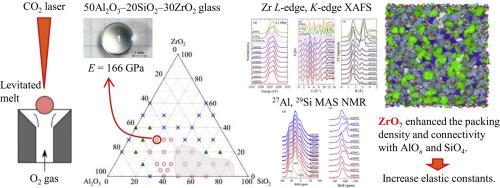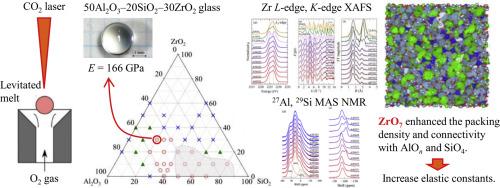Densely packed glass structure caused by seven-coordinated Zr in high elastic modulus Al2O3–SiO2–ZrO2 glasses
IF 8.3
1区 材料科学
Q1 MATERIALS SCIENCE, MULTIDISCIPLINARY
引用次数: 0
Abstract
Al2O3–SiO2–ZrO2 ternary glasses were fabricated using a levitation technique. The addition of ZrO2 to the Al2O3–SiO2 glasses strongly affected their thermal, mechanical, and structural properties. Several compositions were partially vitrified at the laser-melted area without levitation although their melting required temperatures higher than 2000 °C. With increasing ZrO2 content, the elastic moduli linearly increased, and the 50Al2O3–20SiO2–30ZrO2 glass exhibited a Young′s modulus of 166 GPa and Vickers hardness HV of 10.6 GPa. Conversely, crack resistance significantly decreased with the addition of ZrO2. Density measurements, Zr L2,3-edge and K-edge X-ray absorption fine structure analyses, and 27Al and 29Si magic-angle spinning nuclear magnetic resonance spectroscopy were performed to investigate the local structure around Zr, Al, and Si in the glasses. Zr formed distorted ZrO7 as in monoclinic ZrO2, which has been rarely found in conventional oxide glasses. The highly oxygen-coordinated Al atoms such as AlO5 and AlO6, were the main components in the glasses rather than AlO4. The majority of Si atoms form SiO4 with four bridging oxygen (Q4). Among the four bridging oxygens, the number of oxygens connected to Al or Zr clearly increased with decreasing SiO2 content. The high packing density of the ternary glasses that resulted in high elastic moduli originated from the highly oxygen-coordinated Zr and Al and their close bonding with SiO4 without generating nonbridging oxygens.


高弹性模量 Al2O3-SiO2-ZrO2 玻璃中七配位 Zr 造成的致密玻璃结构
利用悬浮技术制造了 Al2O3-SiO2-ZrO2 三元玻璃。在 Al2O3-SiO2 玻璃中添加 ZrO2 对其热性能、机械性能和结构性能有很大影响。尽管熔化所需的温度高于 2000°C,但有几种成分在激光熔化区域部分玻璃化,而无需悬浮。随着 ZrO2 含量的增加,弹性模量呈线性增长,50Al2O3-20SiO2-30ZrO2 玻璃的杨氏模量为 166 GPa,维氏硬度 HV 为 11 GPa。相反,抗裂性随着 ZrO2 的添加而明显下降。为了研究玻璃中围绕 Zr、Al 和 Si 的局部结构,我们进行了密度测定、Zr L2,3-edge 和 K-edge X 射线吸收精细结构分析,以及 27Al 和 29Si 魔角旋转核磁共振波谱分析。锆在单斜 ZrO2 中形成了扭曲的 ZrO7,这在传统的氧化物玻璃中很少见。玻璃中的主要成分是高度氧配位的铝原子,如 AlO5 和 AlO6,而不是 AlO4。大部分硅原子与四个桥接氧(Q4)形成 SiO4。在四个桥接氧中,与 Al 或 Zr 连接的氧的数量明显随着二氧化硅含量的降低而增加。三元玻璃的高堆积密度导致了高弹性模量,这源于高度氧配位的 Zr 和 Al 以及它们与 SiO4 的紧密结合,而不会产生非桥氧。
本文章由计算机程序翻译,如有差异,请以英文原文为准。
求助全文
约1分钟内获得全文
求助全文
来源期刊

Acta Materialia
工程技术-材料科学:综合
CiteScore
16.10
自引率
8.50%
发文量
801
审稿时长
53 days
期刊介绍:
Acta Materialia serves as a platform for publishing full-length, original papers and commissioned overviews that contribute to a profound understanding of the correlation between the processing, structure, and properties of inorganic materials. The journal seeks papers with high impact potential or those that significantly propel the field forward. The scope includes the atomic and molecular arrangements, chemical and electronic structures, and microstructure of materials, focusing on their mechanical or functional behavior across all length scales, including nanostructures.
 求助内容:
求助内容: 应助结果提醒方式:
应助结果提醒方式:


